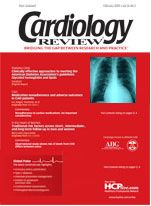Publication
Article
Cardiology Review® Online
Prehypertension raises risk of stroke; risk is greater in African Americans
NEW ORLEANS—Prehypertension—
as defined by the Seventh Report of the Joint National Committee on Prevention, Detection, Evaluation, and Treatment of High Blood Pressure (JNC 7)—is associated with excess stroke risk, said Daniel T. Lackland, PhD, at the American Stroke Association’s International Stroke Conference 2005. The excess stroke risk at all levels of blood pressure is greater for African Americans compared with whites.
JNC 7 defined prehypertension as a systolic blood pressure (SBP) of 120 to 139 mm Hg and a diastolic blood pressure (DBP) of 80 to 89 mm Hg.
Dr. Lackland and colleagues evaluated data from the Black Pooling Project, which includes 9 follow-up cohort studies with 8,920 African American women, 7,175 African American men, 27,606 white women, and 37,413 white men. Cardiovascular mortality rates were determined for each group by the four classifications of blood pressure—normal (< 120/< 80 mm Hg), pre-hypertension (120 to 139/80 to 89 mm Hg), stage 1 hypertension (140 to 159/90 to 99 mm Hg), and stage
2 hypertension (≥ 160/≥ 100 mm Hg). African American men and women were more likely to be hypertensive, whereas prehypertension was more prevalent among white men and women.
The stroke mortality rates increased with blood pressure level among all four race-sex groups. “African American men and women had higher stroke risks at each of the blood pressure categories compared with their white counterparts,” said Dr. Lackland, professor and director of graduate training and education, Medical University of South Carolina, Charleston.
Prehypertension was associated with increased stroke risks for each of the four race-sex groups, but prehypertension imparted a twofold greater risk of stroke among African Americans compared with whites. SBP values were consistently better predictors of stroke than DBP.
Among those with prehypertension, the age-adjusted stroke mortality rates per 10,000 person-years were 7.8 for white men, 22.9 for African American men, 7.7 for white women, and 20.5 for African American women. For those with stage 1 hypertension, these rates were 12.5, 20.0, 16.1, and 18.6 for white men, African American men, white women, and African American women, respectively.
The findings “emphasize the need for aggressive blood pressure control to reduce the racial disparity in stroke,” he said. “These results of the Black Pooling Project indicate the importance of blood pressure control in the total population and suggest a population goal of the lowest blood pressures as beneficial in reducing stroke risk.”
The JNC 7 guidelines do not currently recommend pharmacologic treatment of prehypertension unless the patient has vascular disease or diabetes, but the guidelines may need to be revisited if the findings from the current retrospective study are confirmed, said Dr. Lackland.
“In the future, we may be talking about blood pressure goals as low as 110/70 mm Hg,” commented Robert Adams, MD, Regents Professor of Neurology, Medical College of Georgia, Augusta.
In another study presented here, hypertension appears not to explain all of the significantly increased risk of stroke for persons living in the South compared with the rest of the country, said George Howard, DrPH, professor and chair of the department of biostatistics, University of Alabama at Birmingham. This finding comes from a national population-based cohort study of 11,606 participants aged 45 years or older.
In the study, awareness of hypertension was higher among African Americans versus whites (92.8% versus 89.2%; P < .001), as was treatment of hypertension (91.0% versus 86.7%; P < .001), but there were no regional differences in awareness and treatment of hypertension. Control of hypertension, however, was substantially lower in African Americans compared with whites (61.7% versus 70.1%; P < .001). Control of hypertension was better in the South than the rest of the country (67.8% versus 64.2%; P = .039).
“The lack of regional differences in awareness, treatment, and control of hypertension implies that factors other than hypertension may be contributing to excess stroke mortality in the Stroke Belt,” said Dr. Howard.
